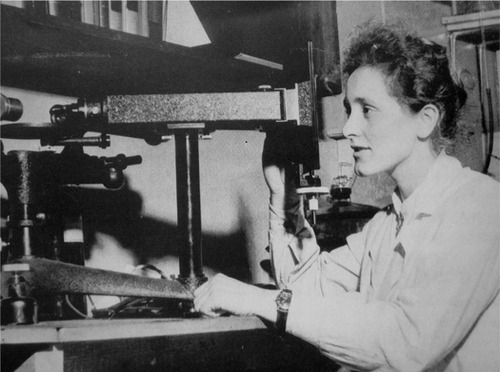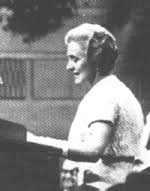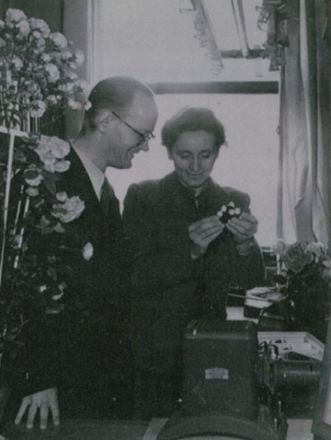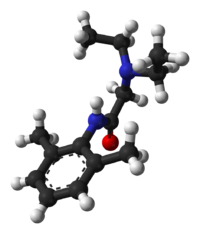Pharmacy and Drug Innovations
OPEN ACCESS | Volume 4 - Issue 1 - 2025
ISSN No: 2994-7022 | Journal DOI: 10.61148/2994-7022/PDI
Juan Núñez-Valdés
Universidad de Sevilla (Spain)
*Corresponding author: Juan Núñez-Valdés. Universidad de Sevilla, Spain
Received: February 09, 2021
Accepted: February 15, 2021
Published: February 26, 2021
Citation: Juan N Valdés. “Inga Fisher-Hjalmar’s, One of the Discoverers of Lidocaine.” J Pharmacy and Drug Innovations, 2(1); DOI: http;//doi.org/03.2020/1.1007.
Copyright: © 2021 Juan Núñez-Valdés. This is an open access article distributed under the Creative Commons Attribution License, which permits unrestricted use, distribution, and reproduction in any medium, provided the original work is properly cited.
With the aim of showing references of women who had to fight hard to achieve their goals at a time when society did not conceive the work of women, this article shows a biography of the Swedish quasi pharmacist Inga Fisher-Hjalmars, who highlighted in various scientific disciplines, mainly Chemistry, Quantum Mechanics, Biology and Medicine, reaching notable discoveries that represented great advances in the development of these sciences.
Introduction
The author believes that a first step to fight against gender inequalities that still exist today, even in countries far from being considered undeveloped, is to show references of women and put them as an example of people who, in order to dedicate themselves to what they really liked and to be able to practique their professions later, had to face all the multiple obstacles that both the customs and the laws of the time imposed on them. As an example of one of these references, this article shows the biography of a Swedish “quasi” pharmacist, Inga Fisher-Hjalmars, who, thanks to her effort, perseverance and tenacity, managed to overcome difficulties of all kinds, including those of gender, that appeared to her in her aspirations to pursue university studies and managed to stand out in many scientific disciplines, which really makes her figure deserving of recognition by society.
There should be no doubt that the enormous scientific work that Inga Fisher-Hjalmars developed throughout her life would have that made her worthy of being awarded one of the most important prizes that are precisely granted in her land, the Nobel Prize, prize that, however, she did not succeed, due to that, presumably as one of the causes of this non-recognition, the fact of having been victim of the so-called “glass ceiling barriers”, effect that many women who stand out in their works have to face habitually.
As one of the objectives of this article is to fight against gender inequalities, it is convenient to indicate that the glass ceiling is a metaphor referring to an artificial barrier that prevents women and minorities from being promoted to managerial- and executive-level positions within an organization. The phrase “glass ceiling” is used to describe the difficulties faced by women when trying to move to higher roles in a male-dominated hierarchy. The barriers are most often unwritten, meaning that women are more likely to be restricted from advancing through accepted norms and implicit biases rather than defined corporate policies (Web1).
Inga Fisher-Hjalmars: Her Biography
Inga Fischer-Hjalmars was born on January 16, 1918 in Stockholm, in the bosom of the family that consisted of her father, the civil engineer Otto Fischer, and her mother Karen Beate Wulff. The parents were Danish. They had come to Sweden after some time after the father had already work in Sweden before they married. The mother had been a teacher in an ordinary school before the marriage, but after it, when she came to Sweden, she couldn not continue teaching. They were married in 1916 and bought the house where Inga Fischer-Hjalmars was born (Anders, 1999). She had a brother and an older sister.
Given the limited financial resources available to her family, Inga Fischer-Hjalmars, who always had an insatiable curiosity, sought the shortest scientific studies to start working as soon as possible (Johansson, 2012).
In this way she obtained her Bachelor's Degree in Pharmacy in 1939, which at that time lasted two years, and then did a Master's Degree in Physics, Chemistry and Mathematics in 1944. Later, she continued her graduate studies, receiving a "licentiat" degree in Mechanics, in 1949, and another in Chemistry, in 1950 (Johansson, 2012).
The complete process of her studies was summarized by Inga Fischer-Hjalmars herself (Figure 1) in an interview she gave in her country. In it, she affirmed that (Anders, 1999)
I did not even start in chemistry but in pharmacy. Since my family didn't have much money I had to earn my living myself. Because of a much shorter duration of studies in pharmacy at that time I started there. I was a pharmacy student for two years and then I took a first examination in 1939. Then the war started, lots of people had to do military service, they needed people in many places. I myself, for instance, had to travel all over the country, had to continue this for quite some time and was not at all in Stockholm.
During this time, I decided that I would not continue with pharmacy. Due to my first examination in pharmacy I could always take jobs for shorter periods and earn money which I could use, in turn, for a longer period of studies because I had learned to live on small expenses. And I also decided to start at the University right away with, at first, chemistry since I knew, as a pharmacist, quite some chemistry.
Later on I also took physics and mathematics. We had in those days one course for normal studies, so to say, but then there were also the longer courses which one could take. They represented the more scientific part. That was for what we called magister, it's not quite the same as a Master in Science, so that I did in chemistry.
In any case, the combination of her knowledges of Pharmacy and Chemistry led her to participate in the discovery of “xylocaine” (a local pain reliever also known as “lidocaine”). At all times she was encouraged by the desire to “know what really happens inside a molecule” and thus access the most basic knowledge about matter and nature (Johansson, 2017). Regarding the discovery, Inga affirmed that (Anders, 1999)
Imagine you have a benzene ring and then you have a chain - you have to synthesize this first. In addition, you have one or two or three other components on this same benzene ring. Now, this person was looking for a good local anesthetic. In that research group I was at that particular time when we tried to chemically realize very many combinations of these constituents and finally found one that was pharmacologically very, very effective.
This was in 1943. We were a whole group of people working together with a person called Löfgren. Löfgren, at that time, was just licentiate. There was a very long way towards the Swedish doctoral degree, and the way to licentiate was a much shorter one. And he had got just that far in his career when he started his own research group with 8 or 10 students. I belonged to it, we worked quite hard, everybody was so very interested in this type of work. We tried very eagerly, as stated before, to synthesize a lot of homologues (2-5). When we had found something very interesting then we wanted to see which property it had, that was very important. So we did not only make the synthesis, we also tried it on our own nerves to see how it worked, we tested everything on our fingertips, despite the fact that we had a biologist in our group. So these were very active years in that group. And then finally in 1943, we found the substance we were looking for.

Figure 1: Inga Fischer- Hjalmars. Source: (Web Image 1)
So I was in the group when Xylocaine was found. I think it is rather remarkable that this group was able to produce a medicine that would continue to survive a period of 50 years! I mean, quite often there are new pharmaceutical substances which will have a commercial life of 5 or 10 years - but this one has survived 50 years! Before Xylocaine there was something called Novocaine but that just disappeared as soon as this one came out. In the United States, by the way, Xylocaine is known as Lidocaine.
In 1947, she published joint Charles Coulson, a notable theoretical chemist at the University of Oxford, an article on how to describe the dissociation of a chemical bond, which was of great repercussion for the advancement of this scientific field.
Regarding this collaboration of Inga Fischer-Hjalmars with Coulson, it is convenient to indicate that he was who initiated the modern era of theoretical chemistry at Oxford. Charles Alfred Coulson (1910–1974), in the Figure 2, had come to Oxford in 1945 as an I.C.I. Scholar in 1945 and was there for only two years, before leaving to take a very good position in Theoretical Physics at King's College London, in October 1947. However, in that short period of time at Oxford he contributed significantly to the development of Chemistry in that University. Later, he would return there in 1952 as Rouse Ball's Professor of Mathematics, where he established a very large and active research group at the Institute of Mathematics.


Figures 2 and 3: Charles Coulson (left) and y Ulf Svante von Euler (right). Sources: (Web Image 2) and (Web Image 3), respectively
Two years later, in 1949, Inga Fischer-Hjalmars began to study theoretical physics with the intention of knowing in depth the behavior of molecules and iniciated her doctoral studies, which culminated in the defense of her Ph. D. Thesis in 1952, at the University from Stockholm, after which she was employed as Associate Professor of Mechanical Physics and Mathematics. During this period, she worked for a year and a half as assistant to Ulf Svante von Euler (Stockholm, 1905 - 1983), a Swedish physician, pharmacologist and university professor who was awarded the 1970 Nobel Prize in Physiology or Medicine, for his work on chemical exchanges in nerve endings (Figure 3).
Inga Fischer-Hjalmars had a very high opinion of Klein. She said that (Web 2):
Oskar Klein was a very broad-minded person. He himself was interested in many things not only in Theoretical Physics as such. He also had some work together with biologists, for instance. And it was also he himself who established these kinds of contacts. He understood that I wanted to get a deeper understanding of the properties of molecules.
In 1955, Inga Fischer.Hjalmar participated in several conferences showing her work. Figure 4 shows a of herself in Austin (Texas) Meeting (Web 2)

Figure 4: Inga FischerHjalmar in Austin, 1955. Source: (Web 2)
Between 1959 and 1963 she directed the Laboratory of Mathematical Physics at the Royal Institute of Technology. About that stage, herself affirmed that (Anders, 1999): “At that time you couldn't get scholarships or funds just for studying, so everyone who didn't have rich parents had to earn money”.
Figure 5 shows an image of the laboratory in which other colleagues and herself appear working. They are, from left to right: Lars Erik Tammelin, Göte Östlund, Nils Löfgren, Lars Ehrenberg, Gunnar Widmark, Bengt Lundquist, Inga Fischer, Gunnar Molander and Elis Sundström. She is, obviously, the unique woman in the photo.

Figure 5: Laboratory of xylocaine.
Source: Astra-Zeneca photo, taken from (Pérez, 2018).
In 1963, she took the place of her thesis advissor, the Swedish theoretical physicist Oskar Benjamin Klein (1894-1977) as professor of Theoretical Physics at Stockholm University (See Figure 6), thus becoming the first woman to hold this position in Sweden. She held that position until 1982 and over time, she had more and more female students. Regarding this she affirmed: “it seems that they realized that if one woman could do it, why not the others” (Pérez, 2018).

Figure 6: Oskar B. Klein, advisor of Inga Fischer-Hjalmars’ thesis in 1922. Source: (Web Image 6)
Inga Fischer-Hjalmars lectures were always very popular and applauded (see Figure 7) and her work was also highly recognized both in her own country and abroad. In 1978, she became part of the Royal Swedish Academy of Sciences as well as the Royal Danish Academy of Sciences and Letters. It also gained extended and strong international recognition by becoming a member of the International Academy of Quantum Molecular Science and the World Academy of Art and Sciences (Web2).

Figure 7: Inga during her intervention in the International Academy of Quantum Molecular Science in 1966. Source: (Web Image 7)
As another of her most notable scientific facets, Inga Fischer-Hjalmars also was the president of the Standing Committee of the International Council of Scientific Unions on Free Movement of Scientists (Anders, 1999), an organization that defended the free work and the movement of dissident and Jewish scientists who lived within of the Soviet Union and who saw their work severely limited or impeded under that regime. For this work, she was rewarded with the Scientists' Human Rights Prize, awarded by the New York Academy of Sciences (Pérez, 2018).
Inga Fischer-Hjalmars married Stig Hjalmars (Figure 8) in 1934. He was a professor of Mechanical Engineering who had been a student of Oskar Klein. Oskar Klein was studying with Niels Bohr in Copenhagen for 10 years and when he was professor in Stockholm from 1930 on, Stig Hjalmar did theoretical research with him on mesons and things like that. Later, he became professor at the Royal Institute of Technology, again at Stockholm. There he had to teach mechanics, became interested in solids, solid states of a more complex nature where there are many different things involved. So he changed to the study of these things as well as to topics which were of special interest to the Royal Institute of Technology (Web 2).

Figure 8: El matrimonio Fischer-Hjalmars. Source (Anders, 1999),
Regardind personal aspects, Inga Fischer-Hjalmars was a very modest person, who never boasted of her successes. Moreover, she was always realized the work of the people she worked with. Asked how she could summarize her discoveries in Quantum Chemistry, she answered the following (Anders, 1999)
No, I thought that one must try to formulate the problem in such a way that one can perhaps make one step forward! That was something that Klein was very eager to tell us. Do never expect that you can take big steps, you must always take small steps in order to achieve something. Oskar Klein was a fascinating personality. I mean even if he didn't work at just the kind of problems that we were involved in he gave us so many such wise advises that one should work in that way (58).
And one should always remember that one was never taking a step just by oneself. One was using what was behind and what the others had done; one should make a small step from where on one could perhaps continue. One should always look upon oneself as part of bigger system, not as an isolated thing. One should try to make a contribution that could be helpful also to others and never to be too eager to tell 'that was my idea', 'that is my idea'! What is important is, that science shall go forward.
On her inclination towards group work and on her activities in the field of Quantum Mechanics, she reflected in the following way (Anders, 1999)
I think that one must try to formulate the problem in such a way that one can perhaps make one step forward! That was something that Klein was very eager to tell us. Do never expect that you can take big steps, you must always take small steps in order to achieve something.
Inga Fischer-Hjalmars (Figure 9) died in 2008. Despite her advances in such complex and unexplored fields, and having been born and worked in Sweden, the cradle of the Nobel, Inga Fischer-Hjalmars never won one, but that did not seem to matter too much to her (Anders, 1999, Roos, 2009 and Anders, 1999)
No. No, no, no. I never thought of that. I realize that I was not of that category yet where there would be a Nobel prize. And that was also not so interesting. Interesting is, if you can take some small steps that would bring the thing forward.

Figure 9: Inga Fischer-Hjalmar in her maturity. Source: (Anders, 1999)
Reflections
The xylocaine, later known as lidocaine (C14H22N20, in Figure 10) is a drug belonging to the family of local anesthetics, specifically of the type of amino amides, among which are also drawncaine, mepivacaine, etidocaine, prilocaine and bupivacaine, whose effects are faster and longer lasting than those of local anesthetics derived from esters, such as cocaine and procaine (Web3).

Figure 10: The lidocaine molecule.
Source: (Web Image 10)
Although Inga Fischer-Hjalmar did not really become a pharmacist, the author believes that her figure should be known and especially valued in the pharmaceutical world. Without reaching the enormous significance of the discovery of penicillin by Sir Alexander Fleming, hes participation in the discovery of that mentioned substance, as a consequence of her work in laboratories run by Nils Lofgren and Bengt Lundqvist in 1943, can be considered as an important milestone in the current development not only of Medicine but also of Pharmacy. And that, also taking into account that at that time she again suffered economic difficulties due to that Löfgren couldn't provide her with sufficient money to live and thus she also had to work in other kinds of jobs until she started to work with the Nobel prize laureate Hans von Euler, who could find some money resources to help her in her research. In this way, she was an assistant for him for and made advantage of it to learn some spectroscopy and physics.
Inga Fischer-Hjalmar, finally, did not graduate in Pharmacy, but there is no doubt that the knowledge she acquired in this discipline during the two years that she was studying it was decisive for the achievement she obtained later.
For this reason and for the fact that she was also an authority in Quantum Mechanics , in which she also made important discoveries that have not been dealt with in this article, the author believes convenient to enhance her figure and show her as a reference and example of a woman who had to overcome various barriers, both economic and gender barriers, imposed on women of her time by society on the one hand and current regulations on the other, which made it difficult for them to access higher education.